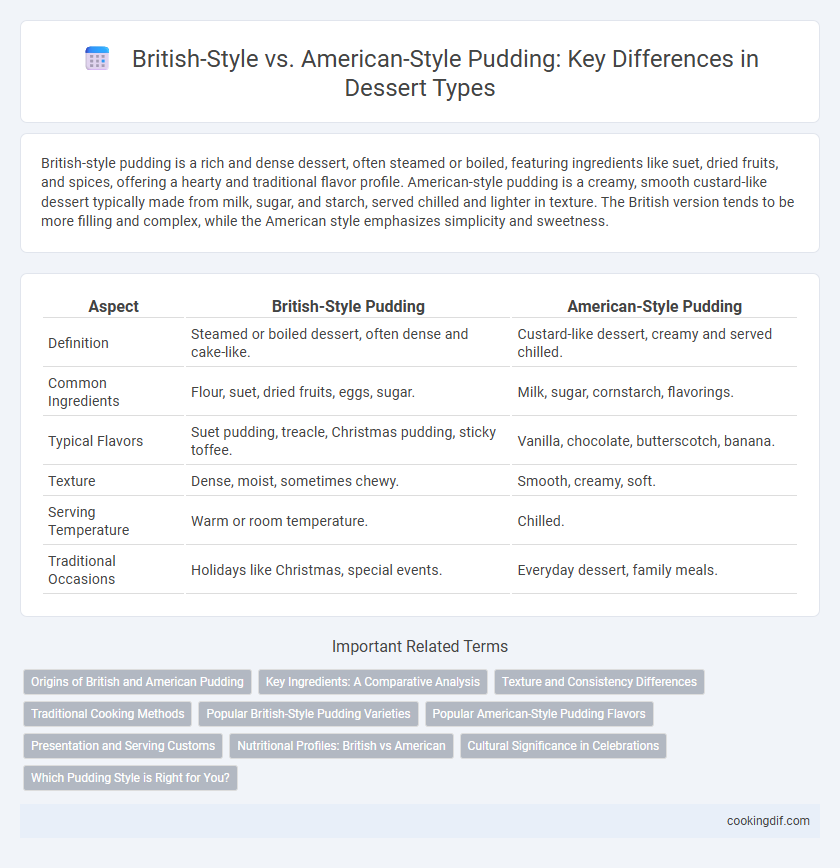British-style pudding is a rich and dense dessert, often steamed or boiled, featuring ingredients like suet, dried fruits, and spices, offering a hearty and traditional flavor profile. American-style pudding is a creamy, smooth custard-like dessert typically made from milk, sugar, and starch, served chilled and lighter in texture. The British version tends to be more filling and complex, while the American style emphasizes simplicity and sweetness.
Table of Comparison
| Aspect | British-Style Pudding | American-Style Pudding |
|---|---|---|
| Definition | Steamed or boiled dessert, often dense and cake-like. | Custard-like dessert, creamy and served chilled. |
| Common Ingredients | Flour, suet, dried fruits, eggs, sugar. | Milk, sugar, cornstarch, flavorings. |
| Typical Flavors | Suet pudding, treacle, Christmas pudding, sticky toffee. | Vanilla, chocolate, butterscotch, banana. |
| Texture | Dense, moist, sometimes chewy. | Smooth, creamy, soft. |
| Serving Temperature | Warm or room temperature. | Chilled. |
| Traditional Occasions | Holidays like Christmas, special events. | Everyday dessert, family meals. |
Origins of British and American Pudding
British pudding traces its origins to medieval savory dishes that evolved into steamed or boiled desserts using suet, flour, and dried fruits, reflecting traditional cooking methods in the UK. American pudding developed from European custard recipes, transforming into a smooth, creamy dessert made with milk, sugar, and cornstarch, popularized in the 19th century as a quick and easy sweet treat. The key distinction lies in British puddings being dense and often steamed, while American puddings emphasize a creamy, custard-like consistency.
Key Ingredients: A Comparative Analysis
British-style pudding typically features suet, flour, and dried fruits as key ingredients, resulting in a dense, steamed dessert often served warm. American-style pudding focuses on dairy elements like milk, sugar, and cornstarch, creating a smooth, creamy texture that is usually chilled before serving. This contrast in base ingredients highlights the cultural variations in texture and preparation methods between the two pudding types.
Texture and Consistency Differences
British-style pudding typically features a dense, steamed or boiled texture that is moist and rich, often resembling a thick cake or custard. American-style pudding is usually creamier and smoother, with a silky, spoonable consistency thanks to its milk or cream base thickened with cornstarch or gelatin. The textural contrast highlights British pudding as hearty and substantial, while American pudding offers a lighter, more velvety dessert experience.
Traditional Cooking Methods
British-style pudding traditionally involves steaming or boiling batter or suet mixtures, resulting in dense, moist desserts like treacle pudding or spotted dick. American-style pudding typically refers to a creamy, custard-like dessert made by cooking milk, sugar, and cornstarch or eggs on the stovetop until thickened. Traditional British methods emphasize prolonged heat exposure and moisture retention, while American recipes focus on quick, stovetop cooking to achieve a smooth, creamy texture.
Popular British-Style Pudding Varieties
British-style puddings are often steamed or boiled desserts known for their rich, dense textures and include varieties such as Sticky Toffee Pudding, Spotted Dick, and Treacle Pudding. These puddings frequently feature ingredients like suet, dried fruits, and treacle, emphasizing hearty flavors and moist consistencies. Unlike American-style puddings, which are typically creamy and custard-based, British puddings are integral to traditional Sunday roasts and festive celebrations.
Popular American-Style Pudding Flavors
American-style pudding is a creamy, custard-like dessert typically enjoyed cold, with popular flavors including chocolate, vanilla, and butterscotch. This version differs from British-style pudding, which often refers to steamed or baked dense desserts like spotted dick or treacle pudding. The smooth texture and sweet taste of American puddings like banana or rice pudding have made them household favorites across the United States.
Presentation and Serving Customs
British-style pudding often features steamed or boiled preparations served warm, typically accompanied by custard or cream, emphasizing a homely and comforting presentation. American-style pudding is usually chilled and creamy, presented in individual cups or layered desserts, highlighting convenience and a smooth texture. Serving customs differ, with British puddings commonly enjoyed as part of a traditional meal course, while American puddings are often served as quick, casual treats or snacks.
Nutritional Profiles: British vs American
British-style pudding often features suet or breadcrumbs, resulting in higher fat and calorie content compared to the American style, which is typically lighter and milk-based. American puddings usually have lower saturated fat but may contain more added sugars and artificial thickeners like cornstarch. Nutritional profiles differ significantly, with British puddings offering more protein and complex carbohydrates, while American varieties emphasize lower fat and convenience.
Cultural Significance in Celebrations
British-style pudding holds deep cultural significance in traditional celebrations such as Christmas and Burns Night, often featuring steamed suet bases with dried fruits symbolizing prosperity and good fortune. American-style pudding, typically creamy and custard-like, is central to casual gatherings and holiday meals, reflecting a preference for sweet, comforting desserts in family-oriented festivities. Both types embody regional identities and festive customs, highlighting their unique roles in preserving cultural heritage through food.
Which Pudding Style is Right for You?
British-style pudding is typically a steamed, dense dessert made from suet or sponge, often served warm with custard, ideal for those who enjoy rich, traditional flavors and textures. American-style pudding, by contrast, is a creamy, custard-like dessert that is chilled and smooth, perfect for those preferring lighter, sweeter, and more gelatinous treats. Choosing the right pudding depends on whether you favor a hearty, warming dessert or a cool, silky finish to your meal.
British-style vs American-style pudding for dessert type Infographic

 cookingdif.com
cookingdif.com